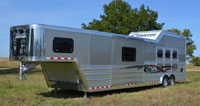If you are in the market for a trailer hitch, there are a few things you need to know before making your purchase. In this article, we will be discussing hitches in general and their common types, such as the ball hitch and receiver hitch. We will also be talking about the different types of trailer hitches that are available on the market today.
Rear Receiver Hitch
A rear receiver hitch is the most common type of hitch used on trucks and SUVs. It is typically used for towing trailers and is installed on the back of the vehicle. This type of hitch is easy to use and is very versatile, making it a great choice for those who do a lot of towing.
There are two main types of rear receiver hitches – Class III and Class IV. Class III hitches are the most common and are typically used for towing smaller trailers, such as boats and campers. Class IV hitches are designed for heavy-duty towing and can be used for larger trailers, such as RVs and fifth wheels.
Front Hitch Mount
This type of hitch is mounted on the front of the vehicle, typically on the bumper. This type of hitch is ideal for carrying lighter loads, such as a small trailer or a bike rack.
If you’re looking for a hitch to carry a heavier load, such as a large trailer, a rear hitch mount is a better option. This type of hitch is mounted on the back of the vehicle, and can typically handle more weight than a front hitch mount.
Gooseneck Hitch
Gooseneck hitches are designed for larger trailers, such as RVs and horse trailers. They offer a higher weight capacity than other types of hitches, and they provide a smoother ride for your trailer. However, gooseneck hitches can be more difficult to install, and they can be more expensive than other types of hitches.
Pintle Hitch
A pintle hitch is a type of trailer hitch that uses a pintle – a small, spiked rod – to secure the hitch to the vehicle. Pintle hitches are often used for heavy-duty applications, such as towing trailers with a large load capacity. They are also sometimes used for towing boats, as the pintle provides a secure connection point that can withstand the force of the water.
Pintle hitches are typically very strong and durable, but they can be more difficult to connect and disconnect than other types of hitches. If you are looking for a hitch for towing a large trailer or boat, a pintle hitch may be the right choice for you.
Bumper Hitch
A bumper hitch is the most common type of trailer hitch. It mounts to the back bumper of your vehicle and typically has a 2″ receiver. Bumper hitches are great for lighter trailers, such as small utility trailers or pop-up campers. However, they can also be used for larger trailers, such as travel trailers or fifth wheels, if they are properly rated.
Custom Hitch
Depending on the weight of the item you’re towing and you vehicle requirements, you may want to get a custom hitch. There are a number of manufacturers out there that can make you a custom hitch.
Weight Distribution Hitch
A weight distribution hitch is a type of trailer hitch that helps to distribute the trailer’s weight evenly between the tow vehicle and the trailer. This type of hitch is often used when towing heavier trailers, such as RV trailers and horse trailers.
Weight distribution hitches are designed to helps improve the stability of the tow vehicle and trailer, and can also help to reduce stress on the tow vehicle’s suspension. They are typically used in combination with a sway control device, which helps to further reduce the risk of trailer sway.
Conclusion
In conclusion, there are a variety of trailer hitches available on the market. The most common type is the ball hitch, which is used for towing trailers. Other types of trailer hitches include fifth wheel hitches, weight distribution hitches, and more. For more information on trailer hitches, visit mrtrailer.com.


















 Automatic Tire Balancers for Trucks and Trailers25% to 50% longer tire life,
Automatic Tire Balancers for Trucks and Trailers25% to 50% longer tire life,  Automated Safety Hitch
Automated Safety Hitch 










 Popup Cushion Coupler Happy Horses Smooth Trailers
Popup Cushion Coupler Happy Horses Smooth Trailers
